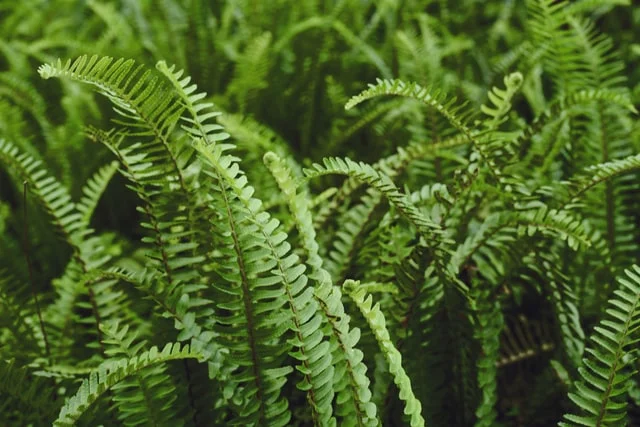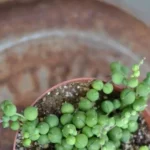The asparagus fern plant is an evergreen perennial that is not really a fern at all. It is from the lily family. Its name is derived from its fern-like appearance.
This plant, whether grown indoors or outdoors, has long, thin stems, producing fronds that have needles instead of leaves. They also produce small thorns along their branchlets. At maturity, the plant may stand between two and four feet tall.
Asparagus ferns are flowering plants, which real ferns are not. They produce whitish-green flowers that turn into reddish-purple berries.
These berries are not edible because they are poisonous, but they add an even more decorative appearance.
Because this species is from the lily family, asparagus fern propagation might be different than expected.
The plants grow from tubers that form a root ball. These roots are very strong, and when grown in a small-sized pot, they are also quite long and compact. It is these tubers, as a part of the root ball, that are used for asparagus fern propagation.
There is an alternative method using seeds harvested from the berries. Though this is not as common, professionals and amateurs alike use this method.
Read more: Why is Your Asparagus Fern Turning Yellow
Table of Contents
Asparagus Fern Propagation Through Root Division
Before you propagates this plant, some preparation is required. The night before, water must be added to the soil – enough to saturate the top three inches of it. The plant needs to sit overnight to allow the roots to hydrate.
The next day, the asparagus fern will be ready to propagate. Several steps are required for this process, but they are fairly simple.
- When you are ready to start, wearing gloves, you can remove the plant from the pot, shaking half of the soil away from the root ball.
- The fronds need to be divided equally before cutting the roots. You can lightly tie the fronds together with a string once they are divided. The roots must be cut according to these divisions.
- At this point, the cutting may be done. You will require a strong, sharp, sterilized knife. The individual will also need a stable area to do the cutting as the root ball can be quite tough. The cutting needs to be completed according to the frond division. The person must cut straight down the root ball each time. This ensures the plant will have all of what it needs to grow and redevelop the root ball.
- The portion of the root ball should be placed in a six-inch pot filled with a slightly acidic, well-aerated, quick-draining potting mix. The mixture should be light, but if not, sand, peat moss, or perlite can be added to it to increase this property. There are potting mixes specifically designed for this species. This kind is recommended if available in your area.
- The soil needs to settle, but this should be done using water instead of hands.
- The newly potted plant can be placed in the same area as the previous plant. This location needs to be bright with indirect light. Watering should be done when the first two inches of the soil are dry. You must not overwater the plant as it can cause root rot or other fungal issues.
- When the plant develops two or three new sets of fronds, it can be transplanted into a larger pot. However, the container should not be more than an inch larger than the original pot of the mother plant.
Asparagus Fern Propagation Using Seeds
The berries grow from summer to winter and can be removed from the plant during these times.
The seeds can then be taken from the berries. Before the seeds may be used for asparagus fern propagation, they must be softened. To do this, you can place the seeds in water for approximately twenty-four hours.
During this time, you can prepare for the rest of the procedure. The preparation must be completed for when the seeds are ready.
- Three-inch pots are to be filled with moistened sterile seed compost.
- After the water is added to moisten the compost, the individual must wait fifteen minutes for the water to drain.
- Holes can then be made where the seeds are to be placed in the soil. These holes should be one-quarter of an inch deep.
This preparation can be started about thirty minutes before the seeds are ready. When the seeds are finished soaking, the following steps can be taken.
- Two seeds may be placed in each prepared hole and covered with compost.
- The pot should then be placed on a germination mat and covered with plastic sheets.
- The temperature during the day needs to be approximately 29 degrees Celsius (85 degrees Fahrenheit) during the day and 21 degrees Celsius (70 degrees Fahrenheit) during the night.
- The watering must be very balanced. Compost does not do well for asparagus fern propagation when it is too dry or too wet. A spray bottle is recommended for this process. The compost should only be watered when it is dry to the touch.
The germination process requires three to four weeks. If you notice that a seedling is weak, it should be removed as it could affect the development of the other plantlets. However, all the seedlings may break through the compost and be quite strong.
Read more: Asparagus Fern Care – A Complete Guide
Frequently Asked Questions
Can you grow asparagus fern from cuttings?
Asparagus fern propagation cannot be completed using cuttings. That method is typically utilized for plants that grow from buds, stems, or leaves.
This species grows from tubers that develop just below from soil’s surface.
As a result, cuttings do not produce roots. Asparagus fern propagation is typically done through root division or by using the berry seeds.
Can you start a fern from a cutting?
An asparagus fern is not a true fern, it is an evergreen perennial from the lily family. Unlike real fern plants, this species grows from tubers that grow close to the soil’s surface.
As a result, these plants cannot be started through a cutting. It requires either root division or the use of seeds from the plant’s berries.
How do you grow asparagus fern from tubers?
Asparagus fern can be grown in this way by removing the plant from the soil and dividing the root ball. Each part of the root ball must have equal numbers of fronds attached.
The tubers can be planted into the same type of soil as the mother plant and placed in a bright location.
How fast does asparagus fern grow?
Asparagus ferns are fast growers. This species takes about three to four years to mature. By this time, in optimal conditions, indoor plants can be up to four feet tall and three feet wide.
Plants that are grown outdoors may be even larger, depending on the pot size, air temperatures, and weather conditions.
This growth, both indoors and outdoors, may be encouraged with the use of light fertilizer.
Photo by Li Xiaohan on Unsplash



